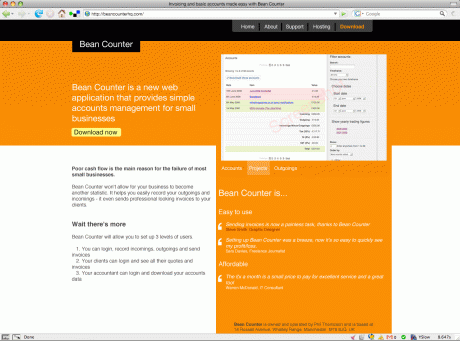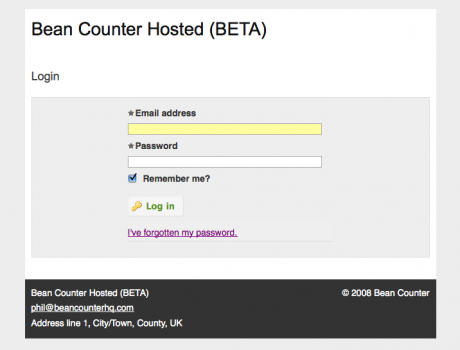I have decided to launch my own web app. The web application in question, is one I mentioned a few weeks ago and it is to be called Bean Counter.
Please note, the above link to Bean Counter works but the links on the site do not. I have put it up ridiculously early in the process to try and gain some SEO points so when I do launch, it will be out of the Google Sandbox.
What’s involved?
This will not be an easy process – it may fail and fall into obscurity or it may blossom and be the start of a new business career for me. I’ve decided to document the process so I have a written record and so anyone in a similar position can see what is involved.
I have been very impressed in the way in which another web app, Sifter has been blogged by its founder(s) and I hope to emulate the interest it has gained by doing a similar job here.
This first post will serve as an overview of what I have done so far and what I plan to do next.
Stage 1: Have the idea
I’m always coming up with ideas for web apps – and they’re always less than good. In between coming up with these ideas, I wrote a little app for myself that attempted to automate my billing process for my sideline freelance projects. Whilst creating this app, it dawned on me that this was the web app idea I’d been searching for.
Prior to writing this app, I was doing my invoices from a template in Word and they were taking me about 10 – 20 minutes. Now they take 2-3 minutes – if that (or do they?.) I think a lot of other people are doing this the long winded way too and I think I can save them time and therefore money.
Is the idea viable?
The marketplace is saturated with invoicing/accountancy apps like Blinksale and Freeagent so what will make my app capable of getting market share? Well, I’m hoping my system will be really simple and really easy to use. It won’t be aimed at just technical people which I think is the case with the current product offerings on the market.
I’m a firm believer in the ‘if you build it they will come‘ motto. If Larry and Sergey hadn’t thought online search could be improved from what Yahoo and Altavista (remember them?) were offering they wouldn’t be billionaires?
So far, there have been no sales – so at present, whether the idea is viable or not is still up for debate but I have some confidence in the idea. I have no external investment so I have to make sure my time is managed perfectly – any time wasted is money lost.
Stage 2: Create the product
In the real world, entrepreneurs create prototypes. In web world, we build and beta test our prototypes. This is the stage I’m at. I’ve refined and added to this system for months and this month I’ve let in some beta testers. I think the app is complete and bug free but it needs still more testing.
The feature set is deliberately limited – going back to stage 2. I can’t waste too much time on this product if it turns out to incapable of generating revenue. So the plan is to launch with limited features and build upon them as time goes on. This is very much an approach stolen from 37signals’ Getting Real.
Stage 3: Launch the product
Argh! Scary times. I’m not quite here yet. Once I reach this stage, I shall be worried beyond belief as it will make the whole process ‘real‘. I’ve set up the sales site (half-way so far – see screenshot) but before I launch I have to ask myself a few important questions:
- What will be the pricing structure?
- Will the app be hosted or downloadable?
- What do I do if things go wrong e.g. how will I provide support?
- What constitutes a success for me?
- If it’s a success – what next, can I make a career from this?
Stage 4: Promote/market the product
It’s all good launching a product but if no-one knows about it then how will they buy it? I have next to no marketing budget so I need to market my web app with a bit more canny knowledge as opposed to TV adverts!
Here’s what I’m planning:
- blog about it (from a technical perspective) here
- set up a separate blog for it
- try to get reviews from other bloggers
- try to get reviews from trade magazines
- try to get interviews on popular podcasts
Those techniques won’t be easy to achieve. Other bloggers/podcasters/industry mags won’t just review the product and tell me how great I am because I ask to but hopefully with a bit of elbow grease the word will get out in the tech community and then the next stage is to get the word out to non-techy people.
Stage 5: Water the product and watch it grow
If the product starts to sell – then I doubt I’ll be able to keep it as a part-time operation – or at least I’ll have to devote more time to it. There will be sales to make, support to give, and upgrades to write. That sounds like a lot of work for one man to do in his spare time.
If this product is a success, then I hope more ideas I have will see the light and be given an opportunity to be successful too.
Summary
This article is rather self-indulgent but I hope you stay with me on this journey – who knows where it’ll lead to.

